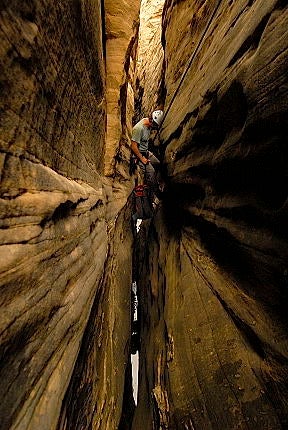Easter Vanishings and Resurrections

Hey campers!
Hope you’re all psyched for Easter Weekend. Don’t forget to pack your brain along with all that enthusiasm. And lots of clothes for the changeable weather. And maybe a cell phone, beacon and First Aid kit, as the following cautionary tales beggar. And right now I’m outta here. Gotta go down the canyon pictured at right. It’s a mission.
Enjoy your holidays. Hike safe. — Steve Howe
American Trekker Missing Five Weeks on New Zealand’s South Island
Edward Dale Reynolds, 39, was last seen breakfasting on the morning of February 23rd at remote Blue Lake in Nelson Lakes National Park on New Zealand’s South Island. Reynolds, an experienced and athletic ultralighter who went by the handle “Fireman,” had been trekking around New Zealand for nearly three months.
A logbook entry left by Reynolds in the nearby East Matakitaki Hut said he’d leave from there on February 24th, head over the steep, glaciated Spencer Range, and finish on the road across Lewis Pass. That trip is a two- to three-day trek, but Reynolds hasn’t been seen since before March. Interpol was alerted about his disappearance when Reynolds failed to pick up gear he’d left with New Zealand friends, and missed his flight back to the states.
The Spencer Range terrain between East Matakitaki Hut and Lewis Pass consists of steep V-shaped gorges covered with thick beech forest, lots of moss covered boulders and river crossings. Crossing the range crest itself involves travel on steep tussock grass, loose glacial moraine and cliff bands. Even the trails tend to be fairly bashy. The hikers who breakfasted with Reynolds described the weather as steady rain with thunderstorms predicted, and new snow on the alpine ridgetops. Authorities note that Reynolds usually carried abut 20 to 22 pounds of gear, wearing running shoes and light clothing.
Search teams, not alerted until the last days of March, have found nothing. Authorities hold no hope for Reynolds unless he left the area unnoticed and is just off-leash. New Zealand buzz is that Reynolds’ lightweight equipment may have contributed to his demise, but no one knows what happened, whether it was hypothermia, or a fall, or a river crossing.
Still, the weather around Lewis Pass can be harsh, and the terrain is slick. If Reynolds, a strong hiker, decided to go off-trail, there are plenty of deadfall thickets and slick boulder fields where he could have been injured, and the beech forests would have hidden and muffled his presence.
The real problematic factor here is that Reynolds had no firm check-in plans during his trip, and was not carrying a beacon. That left him with zero back-up in the event of a stranding injury. Being in an unfamiliar environment, and distant from family or friends who might have become alarmed without periodic contact, only compounds an emergency. Ultralight gear is just one more complication.
Hiker Finds Suicidal Professor’s Body in Canyonlands
In a follow-up to one of my posts from last May, a hiker in the Needles District of Canyonlands found the skeletal remains of Jerry Wolff, 65, a biology professor from St. Cloud State University in Minnesota, who didn’t check-in after a 5-day solo trek thru Salt Creek last May. Wolff’s non-return triggered a search that lasted several weeks and included 50 ground searchers, two search dog units, and aerial overflights by plane and helicopter.
Several days after the search began, Wolff’s hometown newspaper reported that the ‘extremely stressed’ professor had left suicide notes. Wolff was never found – until this March 19th, when hiker Tom Gagnon of Rock Springs, WY came across the skeletal remains of Wolff at the base of a cliff. He had shot himself with a pistol. While it seems a good way to go, suicides are becoming common in national park and wilderness areas. Usually they occur closer to the road, saving searchers a protracted and hopeless epic.
Butane Lighter Saves Trio of Americorps Hikers
On Tuesday, April 8th, about 11:30 a.m., four young AmeriCorps volunteers took off up the Horse Thief Canyon Trail area above the community of Crown King near Prescott, Arizona. Among them were three young males, Trevor Buglio, 19, Aubrey McMullin, 18, and Lauren Atkinson, 23. The group as only minimally prepared in shorts and t-shirts, with a few snacks, cell phones and a cigarette lighter between them. About 9 p.m., one of the group, who made it out, notified the Yavapai County Sheriff that they’d split up and the others were lost.
The remaining trio was in intermittent cell phone contact, but sheriffs couldn’t obtain a solid signal to triangulate their location. Basically, the boys hunkered down and built a fire, which was spotted by searchers. Ground teams met them about 3 a.m.. All three were in good condition and were escorted to trailhead by seven. Interestingly, the Sheriff’s Department release notes how important the lighter was in ‘signalling rescuers’.
Actually, that was the least of it. A butane lighter can mean the difference between life and death in an overnight stranding. The group was fine when located, and strong enough to walk out on their own. They probably could have self-evacuated the next day, even as clueless as they apparently were. This otherwise mundane incident illustrates the importance of taking a map and decent clothing, and having a group plan rather than wandering freeform – but mostly it’s about always having the means to start a fire.
Without one, they would have had a tough time getting to 3 a.m., much less trailhead.